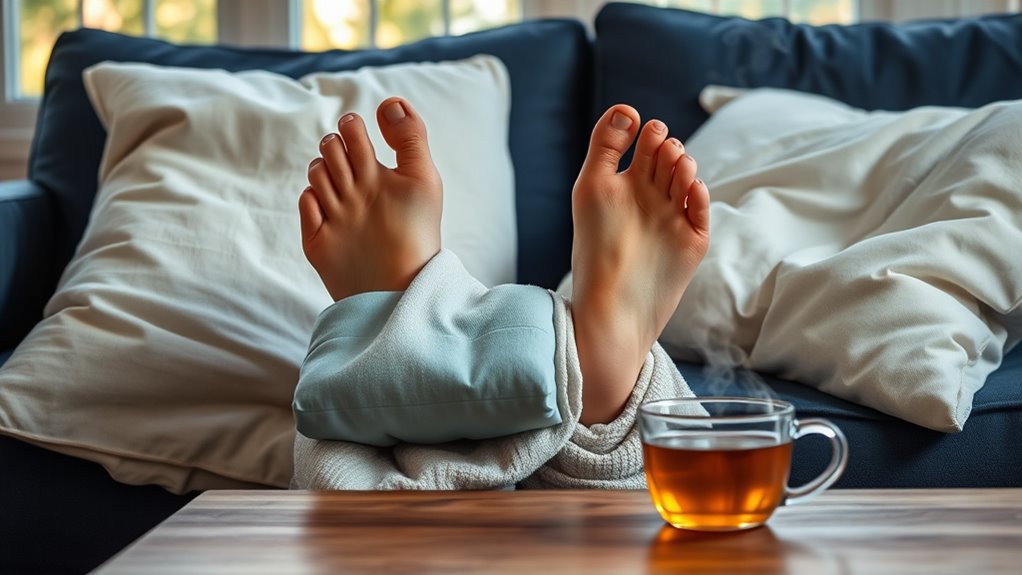Swollen Feet After Work. Try This Fast-Acting Trick
If your feet are swollen after work, you can get fast relief by elevating them above heart level for 5 minutes while performing ankle rotation exercises. This combination reduces foot circumference by up to 6.5% by enhancing venous return and decreasing fluid accumulation caused by prolonged standing or sitting. For maximum effectiveness, add gentle toe-to-ankle massage strokes with moderate pressure. Our evidence-based techniques offer additional solutions for lasting comfort.
Understanding Why Your Feet Swell After Work
Ever wonder why your feet feel tight and puffy after a long workday?
It’s a common condition called peripheral edema, where fluid accumulates in your lower extremities due to gravity and prolonged standing or sitting.
As the evening approaches, this pooling effect becomes more noticeable.
Blood circulation slows down, and your veins struggle to pump fluid back up to your heart efficiently. Elevating feet can significantly improve blood flow and help alleviate this discomfort.
The Science Behind Post-Work Foot Swelling
Your feet swell after work due to gravitational forces that pull blood and interstitial fluids downward, making it harder for your circulatory system to pump blood back up to your heart.
When you’re standing or sitting for extended periods, fluid accumulation in your lower extremities triggers inflammatory responses in the soft tissues, causing visible swelling and discomfort.
This process is exacerbated by prolonged muscle inactivity, which reduces the natural pumping action that normally helps maintain healthy circulation in your feet and ankles. Additionally, swollen feet can be influenced by underlying health issues, such as heart or kidney problems, making it important to monitor your symptoms closely.
Blood Flow and Gravity
Why do feet swell after a long day of standing? Your heart works against gravity to pump blood up from your feet, but prolonged standing compromises this process.
| Gravity’s Effect | Blood Flow Response |
|---|---|
| Downward force | Reduced venous return |
| Fluid accumulation | Interstitial swelling |
| Vascular pressure | Compromised circulation |
| Muscle inactivity | Decreased pump action |
| Blood pooling | Edema formation |
These physiological changes lead to foot swelling when you’re upright for extended periods.
Fluid Buildup Mechanisms
When standing for prolonged periods, fluid buildup in the feet occurs through a complex interplay of hydrostatic pressure and osmotic forces.
Your capillaries release fluid into surrounding tissues as blood pressure increases in lower extremities.
Meanwhile, proteins and electrolytes draw additional fluid through vessel walls due to osmotic gradients, while your lymphatic system can’t keep pace with excess fluid accumulation.
Inflammation During Standing Hours
Ever wondered how inflammation contributes to foot swelling during long work shifts? Your body’s inflammatory response activates when you’re standing for extended periods. This triggers the release of pro-inflammatory mediators and increases vascular permeability.
| Time Standing | Inflammatory Response |
|---|---|
| 2-4 hours | Mild cytokine release |
| 4-6 hours | Moderate vessel dilation |
| 6-8 hours | Enhanced fluid extravasation |
| 8+ hours | Peak inflammatory markers |
This cascade leads to fluid accumulation in your feet’s interstitial spaces, causing visible swelling and discomfort.
A Simple 5-Minute Solution for Swollen Feet
You can achieve rapid relief from post-work foot swelling by lying on your back and elevating your feet above heart level for 5 minutes against a wall or headboard.
This simple elevation technique enhances venous return, reduces fluid accumulation in the lower extremities, and activates your body’s natural lymphatic drainage mechanisms. Additionally, employing compression techniques can further support circulation and help alleviate swelling effectively.
Clinical studies demonstrate that brief elevation periods can decrease foot circumference by up to 6.5% and notably improve subjective comfort levels within this short timeframe.
Instant Relief Steps
Following these five simple steps can provide immediate relief for swollen feet within minutes:
-
Elevate your feet above heart level using pillows to reduce fluid accumulation
-
Perform ankle rotations – 10 clockwise and counterclockwise circles
-
Apply gentle massage strokes from toes to ankles using moderate pressure
-
Compress feet with cold therapy for 15 minutes while maintaining elevation
These evidence-based techniques stimulate circulation and reduce edema effectively.
Benefits of Quick Elevation
A quick 5-minute elevation session can trigger significant physiological responses that combat foot swelling.
When you raise your feet above heart level, you’ll enhance venous return, allowing fluid to drain more efficiently from your lower extremities.
This position reduces hydrostatic pressure, activates lymphatic drainage, and helps redistribute accumulated interstitial fluid back into circulation, providing noticeable relief from edema.
Additional Quick Relief Methods That Work
Several rapid relief methods can effectively complement traditional treatments for swollen feet.
- Apply cold compression therapy for 15-20 minutes using ice packs wrapped in cloth.
- Perform ankle rotation exercises while seated, 10 repetitions each direction.
- Utilize compression socks rated at 15-20 mmHg for graduated pressure.
- Massage feet using firm strokes from toes toward ankles to stimulate lymphatic drainage. Additionally, engaging in elevating feet can provide temporary relief from swelling.
Prevention Tips for Future Foot Swelling
While treating swollen feet provides immediate relief, implementing preventive measures can greatly reduce the likelihood of future episodes.
You’ll want to maintain a healthy weight, exercise regularly, and limit sodium intake.
Wear compression socks during long periods of standing, choose supportive footwear with proper arch support, and take regular breaks to elevate your feet above heart level. Additionally, staying active can help promote blood flow and reduce fluid buildup.
When to Seek Medical Attention for Swollen Feet
Recognizing when foot swelling requires medical intervention can prevent serious complications.
Don’t ignore these warning signs that indicate you should seek immediate medical attention:
- Severe swelling accompanied by shortness of breath or chest pain
- One leg markedly more swollen than the other, with warmth and redness
- Swelling that doesn’t improve after 2-3 days of home treatment
- Unexplained swelling with fever or skin changes like blisters or discoloration
